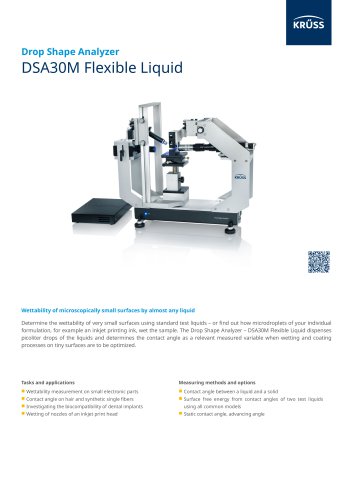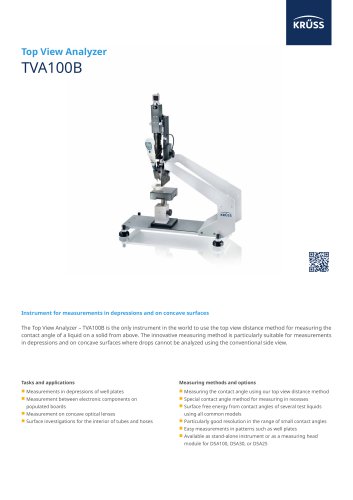 Website:
KRÜSS GmbH
Website:
KRÜSS GmbH
Group: Krüss
Catalog excerpts

Technical Note Effect of drop volume on static contact angles Technical note: Industry section: Drop Shape Analyzer – DSA100 Method: Keywords: Sessile drop, Young-Laplace, Capillary length, Drop volume Effect of drop volume on static contact angles Abstract Measurement of contact angles of sessile drops deposited on surfaces is a powerful analysis tool that is widely used in several industry sectors, from cosmetics to semiconductors, coatings and food industry, wettability studies, surface treatments control, adhesion performance prediction, etc. The purpose of this short note is to treat one recurrent question users have when measuring static contact angle: “How big a drop size should I use?” Indeed, the drop volume is important as we will see, in order to be sure that no size effect is influencing measured contact angles. Surface and Contact Angle of Sessile Drops When a drop is deposited onto a solid surface there are three interfaces involved: solid/air, solid/liquid and liquid/air. Once created, the drop will then instantly try to equilibrate the system by minimizing its energy at interfaces. This is mainly achieved by surface minimization between liquid and other phases. Practically, this state is reached when forces acting on the triple line solid/liquid/air are equilibrated. Young was the first in 1805 to propose a description of the phenomena, by projecting the forces at the three-phase contact line: We can then say that the lower the contact angle θ is the more is the liquid wetting the surface. Equilibrium geometry of the liquid drop is reflecting the interactions between the surface and the liquid. Measured contact angles can then be used in conjunction with theories published in scientific literature to determine the surface free energy of solid, characterizing solid surfaces regarding wettability or adhesion properties. KRÜSS GmbH | Borsteler Chaussee 85 | 22453 Hamburg | Germany | www.kruss.de
Open the catalog to page 1
The use of a goniometer allows precise determination of the contact angle value of a liquid on a surface along the triple-phase line, since the image analysis is done on a projection of the sessile drop. Drop size study Generally, when creating a drop at the tip of a needle, the volume used is of the order of a couple of microliters. Then, in practice the drop and the sample surface are brought in contact. Once the drop touches the surface, the needle and the surface are separated in order to leave the drop reach equilibrium on the surface. Depending on the affinity of a liquid on a...
Open the catalog to page 2All KRÜSS GmbH catalogs and technical brochures
-
DROP SHAPE ANALYZER – DSA30M
2 Pages
-
DSA30M Flexible Liquid
2 Pages
-
Product Overview 2025
84 Pages
-
Tensíío
2 Pages
-
Ayríís
2 Pages
-
FORCE TENSIOMETER – K20
2 Pages
-
FORCE TENSIOMETER – K6
1 Pages
-
TOP VIEW ANALYZER – TVA100B
2 Pages
-
DROP SHAPE ANALYZER – DSA30
2 Pages
-
DROP SHAPE ANALYZER – DSA30R
2 Pages
-
Drop Shape Analyzer DSA25
2 Pages
-
DROP SHAPE ANALYZER – DSA100
2 Pages
-
Dynamic Foam Analyzer DFA100
2 Pages
-
DSA100, DSA30, EasyDrop
5 Pages
-
DSA100, DSA30
4 Pages
-
DSA100
3 Pages































